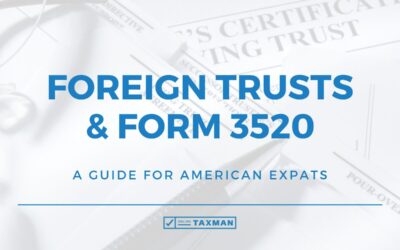Should International Business Travelers Use Per Diem Travel Expenses?

By Vincenzo Villamena, CPA
Tracking travel expenses in order to get reimbursed or to deduct them from your taxes can be a lot of hassle. You have to keep detailed receipts for everything. One way however to simplify expense tracking is using a fixed per diem amount instead of actual expenses. Per diems can have additional advantages if used correctly.
This is an in-depth post that covers:
- Simplify record-keeping with per diems instead of actual expenses
- Who can use per diems for travel expenses
- Which travel expenses are tax deductible
- How expats and digital nomads can deduct travel expenses
- How per diems work for travel expenses
- Per diems for employees
- Per diems for self-employed
- The Do’s and Don’ts of using per diems for business travel
Simplify record-keeping with per diems instead of actual expenses
Typically, you would have to keep track of every receipt for every expense. Instead of keeping records of your meal and other expenses to deduct the actual cost, you can generally use a standard allowance, called per diem. Per diem rates are available for meals and incidentals (M&IE) and also for lodging.
Using per diems does not mean you don’t have to keep any records or documentation. You still have to prepare an expense report, showing the date, place, business purpose, business relationship of any parties involved, and receipts for items not covered by the per diem. If you use a per diem, list the allowance amount in the expense report instead of the actual expense.
Who can use per diems for travel expenses
Per diem rates can be used to reimburse employees for travel expenses. In addition, self-employed people such as travel bloggers, copywriters, magazine editors, and others, who travel often for work, can use per diems to deduct meals and incidental expenses from their taxes. For lodging, however, self-employed cannot use per diems and should use actual expenses with receipts instead. Temporary digital nomads in global rotation programs like Remote Year might also qualify. However, full digital nomads without a home wouldn’t.
Which travel expenses are tax-deductible
Your travel expenses can be tax-deductible business expenses if they are “ordinary and necessary” expenses of traveling away from your home for your business or job. They include transportation, lodging, meals and incidentals, such as tips.
Companies usually reimburse their employees for these travel expenses. Previously, as an employee, you could deduct any unreimbursed expenses. The new tax law however eliminated deductions for unreimbursed employee expenses for the tax years 2018 through 2025. This means only businesses and the self-employed can now deduct those expenses.
The IRS defines business travel as travel for work that requires you to be away from your tax home for longer than an ordinary workday. Expenses incurred for a temporary work assignment away from your home for less than one year can also qualify as tax-deductible travel expenses.
Typical tax-deductible business travel expenses include:
- Travel by airplane, train, bus, or car between your home and your business destination. However, if you travel on a free ticket as part of a frequent traveler or similar program, your cost is zero. You cannot deduct the estimated value of the miles you used.
- Lodging including stays at Airbnb can be deducted. Again, if you are using points for a free hotel stay, this is not tax-deductible. If you are an independent contractor, you can deduct the actual lodging expense but can’t use per diem. More on that below.
- Fares for taxis and Uber or similar types of transportation between the airport or train station and your hotel, the hotel and the work location, and from one customer to another, or from one place of business to another. If using a car, you can deduct actual expenses or the standard mileage rate, as well as business-related tolls and parking fees.
- Shipping of baggage and work-related material such as samples between your regular and temporary work locations.
- Meals, although business meals can only be deducted at 50% of the unreimbursed cost.
- Incidentals such as tips, which is capped at $5 per day.
How expats and digital nomads can deduct travel expenses
As an expat with a fixed home abroad, you can deduct expenses incurred by business travel. For example, if you live and work in Madrid and pay Spain taxes, you can deduct travel expenses on your US tax return for work that requires you to be away from Madrid.
Expats on short term assignments may receive per diem payments for the duration of the stay. If the intended stay is one year or more, however, the expat is living at the assigned location and cannot deduct assignment-related travel expenses.
If you have more than one place where you live and work, then generally the place where you spend more time or where most of your revenue is generated, is considered your tax home.
For more nomadic expats, however, the key is “travel away from your home”. If you don’t have a home that you travel from and back to, you likely won’t be able to deduct your travel expenses.
How per diems work for travel expenses
Per diem rates are fixed location-specific amounts to compensate for travel expenses such as accommodation, meals, and incidental expenses.
The standard per diem rate in effect from Oct 1, 2018 to Sep 31, 2019 for travel within the continental US is $195 total (accommodation, meals and incidentals). The rate for just meal and incidental expenses (M&IE) is $60. In addition, the IRS publishes special rates for over 400 high-cost locations and even for more expensive travel times, meaning some locations are only considered high cost during certain times of the year.
For international travel, the U.S. Department of State establishes per diem rates for all foreign areas, including a maximum rate for lodging and a rate for meals & incidentals.
Per diems for employees
An employer can use a per diem rate to reimburse employees for combined lodging and meal costs, or for meal costs alone. As long as those per diem payments do not exceed the federal per diem rate and the employee provides an expense report, they are not taxable income.
In general, expenses have to be “substantiated” with actual receipts or are “deemed substantiated” as per diem rate no higher than the federal per diem rate. Therefore, an unsubstantiated reimbursement higher than the federal per diem rate is considered taxable income.
With the new Tax Cuts and Jobs Act in effect, employees can no longer deduct unreimbursed travel expenses.
Per diems for self-employed
As independent contractor or self-employed freelancer you are basically both the employer AND the employee. That does not let you off the hook for tracking certain expenses and preparing an expense report with dates, places, business purpose, etc. If you have your own company (such as an S Corp), then you should deduct the expenses directly from the business.
Also keep in mind that the self-employed can only use per diem for meal costs, not for lodging.
The Do’s and Don’ts of using per diems for business travel
Using per diem rates can have advantages in many situations if used correctly. However, per diems are not free money or tax deductions without any paperwork. If you are using per diems for business travel expenses, keep the following in mind:
Do
- Only use per diems that do not exceed the location-specific federal rate to avoid tax issues.
- Keep track of date, place, business purpose, and business relationship with any party involved for your expense report. You need those records even when using per diem rates.
- Prepare an expense report.
- Check the per diem rates for your destination and compare it with your expected actual cost to see which one is more beneficial.
Don’t
- Forget to keep receipts of other expenses. Per diems only cover meals and incidentals and a maximum lodging rate. Transportation, shipping, or other business-related expenses must be claimed separately, supported by receipts.
- Deduct travel paid for with miles, points, etc. Those are not tax-deductible.
- Combine Lodging and M&IE rate. You cannot use an “unused” portion of one allowance and apply it to the other. For example, if your hotel is more expensive than the maximum lodging rate but your M&I expenses are below, you cannot apply part of the M&IE to your hotel bill.
- Use per diem for lodging if you are self-employed. As an independent contractor you cannot use per diem for lodging.
Example
In Cartagena, Colombia’s most expensive city, the maximum per diem lodging rate is $304 and M&IE is $107. You can find a nice 1 bedroom apartment in the old city on Airbnb for under $100 or 4 star hotels on booking.com for under $200. In this case, using the per diem rate has advantages. But you have to be consistent. You cannot use per diem for one day of the business trip and actual cost for another.
To receive more expat and travel-related tax info right into your inbox, please sign up for our free newsletter.
Ready to seek assistance with your US taxes?

Vincenzo Villamena, CPA
Stay Informed With The Online Taxman Newsletter
Your Title Goes Here
Text goes here






